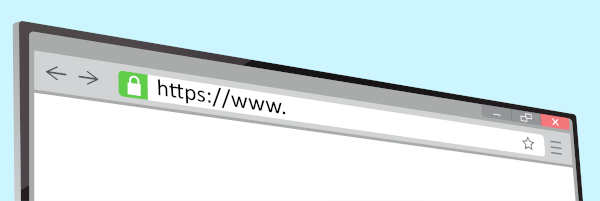 You may have noticed many business websites now have a green padlock in the address bar next to the letters ‘https’. Until recently, you would have only see that on shopping or banking sites, but it is now become the expected norm for all business websites – even if you don’t need users to log in or enter credit cards. Simply put, the ‘s’ in https stands for secure and means any data sent and / or received by the visitor is encrypted.
You may have noticed many business websites now have a green padlock in the address bar next to the letters ‘https’. Until recently, you would have only see that on shopping or banking sites, but it is now become the expected norm for all business websites – even if you don’t need users to log in or enter credit cards. Simply put, the ‘s’ in https stands for secure and means any data sent and / or received by the visitor is encrypted.
Clearly, this is an essential feature for e-commerce sites, but why have all the info-only websites started using https too?
The New Google Rule
As of July 2018, Google will mark your website as insecure unless you use https. It is a movement they started a few years ago to make the internet a more secure place by default. Since Google pretty much rule the internet search and increasing security is always a good idea, business websites have been gradually switching over. Without https protection, someone with access to your internet connection, whether from digital eavesdropping or hacking, could intercept the information. They could also place malware onto otherwise legitimate sites and infect innocent visitors. That is why eighty-one of the top 100 sites online have already switched to https and a very large majority of others are following suit.
The Browser Bar Says It All
In the same way a green padlock in the browser bar indicates a trustworthy site, you can expect that non-https sites will be marked with a “not secure” warning. Previously, users had to click an information symbol to actively investigate the security status of sites. This shift to plain sight markers will be most noticeable on Chrome, however it is expected that other browsers will follow suit. Future visitors to your site may then be alarmed by seeing that the connection isn’t secure.
The fact that you may not be asking them to log in, enter personal details or payment is irrelevant as perceptions matter. Eventually that warning will be changed to an alarming red as Google declares war on insecure sites. As the common understanding is that a warning is bad, you may get more visitors bouncing straight away or even contacting you to report that your site has a problem.
Boosts for Secure Sites
Google is also taking its commitment to safe web browsing further by favouring https websites. This means that Google’s search algorithm is taking your site security into account, preferring https results. Since https status get preference in search results, you may find yourself climbing in the ranking while other businesses drop. It really is a win-win situation for you to implement https..
How to proceed?
It is a little more complicated than just changing a setting within your web hosting environment. You have to order an install a SSL (Secure Sockets Layer) certificate and then install it within your hosting environment. The easiest way to do this is to contact your IT technician or web developer, as they will be able to make sure that it is all done correctly and thus will keep Google happy.
We can help secure your website by migrating it to https – contact us today at 08 83264 364 or su*****@dp*********.au.
